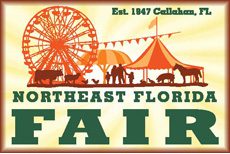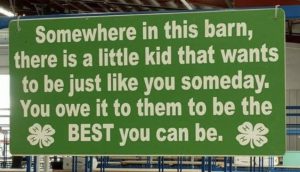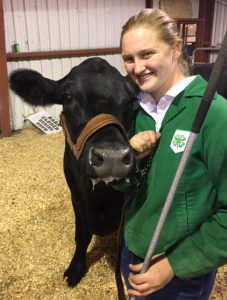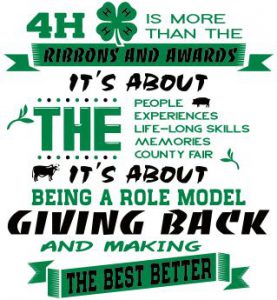 This is probably one of our most asked questions, especially by families first wanting to join 4-H.
This is probably one of our most asked questions, especially by families first wanting to join 4-H.
The fair is an important aspect for many of our 4-H members and we strongly believe in the lessons learned from the barn. However, the process can feel a little overwhelming and we want showing to align with the overall mission with 4-H.
Getting Started
1. The Northeast Florida Fair is held mid October in Callahan. Animals can only be shown by bona fide 4-H members, meaning they have enrolled in 4-H Online, paid their membership fee, and have been an active member in both club and county level 4-H programming. Agents verify all memberships and participation. Clubs can compete for herdsman awards for their club areas, win premiums for their animals, decorate club hay bales or pallets, and compete in showmanship beyond their species specific classes. Members can also compete as an independent 4-H’er and not necessarily be a part of a particular club. Youth can also be a member of non-animal clubs and still show in the fair. For full 4-H guidelines please see this DOCUMENT. There are some species limitations for Cloverbuds (ages 5-7). Club leaders and the county 4-H agent can help you.
2. Members wanting to show animals of all species must complete and return a Fair Points Form by August 1st to the 4-H agent.
A Fair Point form with 5 qualifying points is required for youth ages 8-18, with the exception for first year showers. Additionally, we recognize members who go above and beyond the 5 required points. Members are encouraged to keep track of ALL their points for a chance at winning the annual prize.
 Fair points are activities that keep members in good standing and are offered throughout the year. The purpose of this system is to help youth develop a broad sense of skills, explore other topic areas, have a sense of belonging to all of 4-H, and master other crucial life skills such as communication. Fair points are easily attained by those who do more than “just show”. Each year the Nassau County 4-H office offers over 50 fair point opportunities to its members. Some points can be done at home and others are accomplished in-person, making it attainable for all member needs. Point opportunities are listed in the monthly Friday Flyer, posted on Facebook, sent out personally through individualized emails for topic specific events, and created as-needed.
Fair points are activities that keep members in good standing and are offered throughout the year. The purpose of this system is to help youth develop a broad sense of skills, explore other topic areas, have a sense of belonging to all of 4-H, and master other crucial life skills such as communication. Fair points are easily attained by those who do more than “just show”. Each year the Nassau County 4-H office offers over 50 fair point opportunities to its members. Some points can be done at home and others are accomplished in-person, making it attainable for all member needs. Point opportunities are listed in the monthly Friday Flyer, posted on Facebook, sent out personally through individualized emails for topic specific events, and created as-needed.
To learn more about Fair Points, please read this BLOG
3.Each animal category requires forms to be signed by the 4-H agent and delivered to the Fair office by September 1st. No late entries are accepted. All exhibitor forms can be found HERE! The 4-H agent will only sign forms of members who have 1. turned in fair points if eligible 2. re-enrolled their membership status for the current program year.
Each animal has it’s own showtime and time frame for exhibition during the fair. For specific species please click HERE to review their particular protocols. Families should be very familiar with the nuances of their species’ rules and expectations, for every animal shown. This could include health requirements, age/sex limitations, registrations, expectations, and handling practices. All shown animals must be purebred, recognized breeds. Additionally, limits on the numbers of animal entries may be enforced per barn. Youth should be selecting their highest quality projects for fair entry.
Each species/barn has a Fair Board member in charge. When in doubt, please contact the Northeast Florida Fair for clarification on any species specific needs.
Market vs Non-Market
When selecting your animals to show they will fall into one of two categories: Market or Non-market. Market animals are those raised for the purpose of being sold for product (meat) at the end of the fair (swine, steer, and market lambs) and non-market animals are those that are not terminal projects such as poultry, rabbit, dairy cow, dairy goat, some beef projects, and some lamb projects.
Families may opt for one project or another based on time allowances at home, finances, husbandry limitations, and personal interest. There is no “best” project, only the ones that work best for your family! Regardless of category all animal projects should be managed by the YOUTH; after all the goal of the fair projects is to teach our youth to be leaders and masters within the agriculture industry. Of course adult mentorship is often required, we want the experience to be primarily the youth. All animal projects should receive continuous quality care including husbandry, handling, and nutrition. Throughout the project members should be continually seeking education, practice, and advice to raise their animals. This can be done through the use of clinics, webinars, club activities, independent study, project books and more.
 Market animals have additional requirements. There are two required weigh-ins for each market animal and a mandatory market meeting held by the fair each year for exhibitors.
Market animals have additional requirements. There are two required weigh-ins for each market animal and a mandatory market meeting held by the fair each year for exhibitors.
At weigh in is when youth with receive their record books for EACH market animal. This is a required component to show in market divisions. They are to be completed between the time of first weigh in and the fair. The specific due date changes each year, so please refer to the current fair book for specifics. The mandatory market meeting is just that…mandatory! All exhibitors MUST attend this meeting even if they have previously shown.
A large part of the market project is the actual “marketing” of your animal for sale. Exhibitors must complete thank-you letters to their buyers and actively promote their project to solicit a buyer. All exhibitors are required to find their own buyers, so the entrepreneurship component of this project should not be understated. Letters must be turned in to the fair before any checks will be cut. The final sale is an exciting, but sometimes difficult day. After all, youth have spent many hours working with and caring for their animals. Saying goodbye isn’t easy.
General Rules to Know
- All livestock must be displayed with a sign including the exhibitor’s name, club or chapter, animal’s breed and date of birth. Not only is this a requirement for herdsman awards, it is important to help educate the public about your animal. Clubs or chapters should have matching signs for cohesiveness between members.
- All animals should be healthy, clean, and well behaved.
- Animals must be maintained by the youth exhibitor at all times!
- Exhibitors are allowed two animals per class in all livestock except market classes, with no more than 5 non-market animals on premise at one time.
- Health forms may be required for your animal. This is done through a veterinarian and must be done BEFORE the fair. Additional health checks by FDACS and/or show officials will be done on site.
- Finally when showing your animal a dress code is enforced. It is mandatory that all exhibitors entering the show ring wear a buttoned down collared shirt with at least 3/4 sleeves, dark blue or back jeans/trousers worn at the waist. Dairy exhibitors may opt for white. 4-H attire is encouraged.
- Showmanship is the class where youth can truly showcase their mastery within their project and handling skills with their animals. Tips and protocol vary between species but regardless it judges the youth’s ability to show off their animal. This requires good handling, confidence, and skill. Continual practice in showmanship BEFORE the fair will not only help you to be more competitive in this class, it will enhance the overall quality of your project and your experience within the project. It is always very evident who does and who doesn’t work with their animals.
The last part of showing animals is largely about etiquette. Fair is a big part of the year and we want it to bring a positive experience for your youth. This simple but critical reminder to be our best selves during this time is one that should never be understated. For simple tips, please read our article on this exact matter HERE.
We know that this is a lot of information to take in, but it should help you get started in your animal showing journey. There is still more to learn! Club leaders, your agent, and your fair officials are all here to support you and answer any questions you may have. We also encourage families to use their first year as a learning year and to shadow/be mentored by experienced youth. Showing in the fair is impactful both emotionally and educationally for families. There’s a reason it’s a keystone part of our year.
Fair is special but it is a lot of work. We believe it is worth it and we hope you do too!
 0
0



